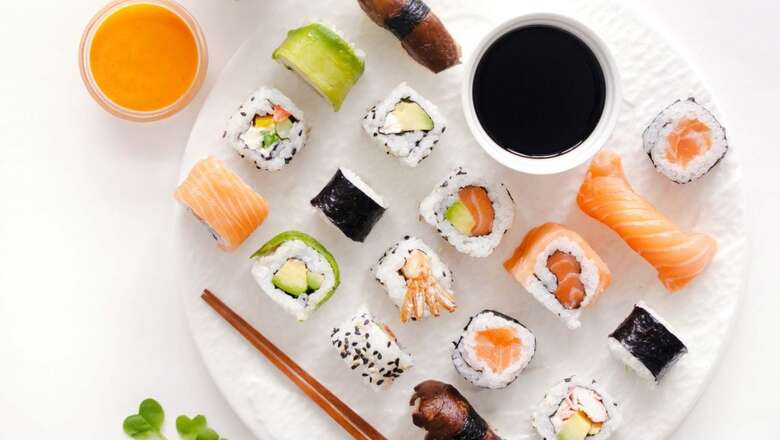
views
Sushi is a traditional Japanese dish that typically consists of vinegared rice combined with other ingredients such as raw fish, seafood, and vegetables. In recent years, sushi has become increasingly popular in India, and as a result, Indian-style sushi has begun to develop. This typically involves the use of local ingredients and spices, such as curry powder and cilantro, to create a fusion of Indian and Japanese flavors. Additionally, many Indian sushi restaurants now offer vegetarian and vegan options, as well as fusion dishes that incorporate Indian flavors into traditional sushi rolls. Overall, the evolution of sushi in India has been driven by a growing appreciation for the dish and a desire to adapt it to local tastes and dietary preferences. We get talking to Harry Hakuei Kosato, founder, Sushi and More, Kikkoman India Representative, and Japanese Cuisine Goodwill Ambassador to understand the palette of Indians and their penchant for sushi.
How has sushi become popular with Indians?
Sushi has been gaining popularity in India over the past several years, and while it has yet to reach the level of popularity of Indian Chinese cuisine, which has a 100-year history in India, the adoption of sushi is accelerating. In the last 8-10 years, sushi has grown from a small business to a more mainstream option, with significant growth in the last 5 years. The COVID-19 pandemic has also led to an increase in demand for sushi, as people sought out healthy and tasty food options that were not home-cooked.
Sushi has been adopted primarily by the rising middle class and young people in India, who are drawn to its unique flavors and healthy ingredients. As a result, sushi has become a preferred option over traditional Western dishes such as fish and chips. The use of Kikkoman soy sauce, which is widely available in India, also adds to the sushi’s umami flavor and makes it even more delicious.
How has sushi, as a dish, evolved over the years?
The evolution of sushi is an interesting adventure. It is the interplay of bold entrepreneurs, hungry foodies, quality ingredients, a rising economy, and exposure to sushi through more overseas travel by Indians, who craved their “sushi fix” at home in India.
Of course, in all of this, we must never ever forget the role of capable and dependable sushi chefs, who are not easy to find, given their level of know-how and skills, and takes much discipline and persistence to deliver the best sushi to the discerning Indian sushi lover.
It started off in 5-star hotels and high-end restaurants. It then slowly started to spread to standalone and then to delivery kitchens. Now, sushi can be found in Pan-Asian restaurants in addition to the 100 or so Japanese food-only restaurants found in India.
How different is Indian sushi from what is served in Japan?
Sushi in India is fundamentally different and yet fundamentally the same as sushi in Japan. The ingredients used in India are different, with a more limited range of options available compared to Japan, where sushi restaurants may have over 100 different types of sushi. However, despite these differences, the core ingredients such as Kikkoman soy sauce, wasabi, nori seaweed, and vinegared sushi rice are essential for both Indian and Japanese sushi.
India still has a long way to go in terms of expanding the range of sushi options available, but popular items like Norwegian salmon, tempura prawns, and avocado rolls are already gaining popularity among Indian sushi lovers. The popularity of these dishes highlights the growing appreciation for sushi in India and the potential for further expansion and innovation in the future.
What’s with The Sudden Rise in Popularity of Japanese Restaurants in India?
It’s part of a global trend. People love sushi. Sushi is one of the top food trends in India, and globally, now.
I think to focus on light, healthy, and really delicious dishes that have a real punch of umami thanks to Kikkoman Soy Sauce which is used to flavor the fresh sushi, this really is a real “sushi fix” kick that aficionados cannot do without – sushi once a week is a popular thing, for Sushi and More, where some 60% are repeat customers.
Also Read: Top 6 Baking Dos and Don’ts You Must Know About
Any myths that you would like to break for the Indians about Japanese food and sushi?
Myth: Sushi is only non-veg and raw.
Fact: Sushi can be enjoyed in many different forms, including Jain, vegetarian, and vegan options. While traditional sushi is often made with raw fish, there are also many delicious cooked options available. These variations of sushi allow for a wider range of dietary preferences and still provide a delicious and satisfying experience.
Myth: Sushi is so expensive.
Fact: No! Sushi started off as street food in Edo (now Tokyo) Japan. So ordinary people could enjoy it at ordinary prices That is actually the philosophy of our brand Sushi and More here in India – we want it to be affordable and reasonably priced but still so yummy!
Myth: Sushi must be prepared by men.
Fact: No! Sushi is now prepared in the modern world by women. Sushi and More has 3 staff members who are women. In Japan, there are sushi bars that are only manned by lady chefs.
Myth: Sushi is the only Japanese food.
Fact: No! Japanese food has a wide range of items, and sushi is not the only Japanese food. It can go up easily to over a few hundred dishes, Japanese food, such is the variety found both regionally and as a result of foreign influences on the food.
Myth: Sushi is like pizza.
Fact: Sushi is a special dish that requires a significant level of skill and expertise to prepare, unlike pizza which is relatively easier to make. This is why there are fewer skilled sushi chefs in India compared to pizza chefs. Sushi used to be considered a luxury item that was only consumed on special occasions, but now it has become more accessible and is consumed more frequently. However, this doesn’t change the fact that preparing sushi still requires a high level of skill and craftsmanship, that takes years to perfect.
The difference between sushi and pizza is that sushi is a delicate and complex dish that is prepared with great care and attention to detail, while pizza can be made more easily and quickly. The fact that pizza can come frozen from a central kitchen makes it a fundamentally different dish from sushi.
Read all the Latest Lifestyle News here




















Comments
0 comment